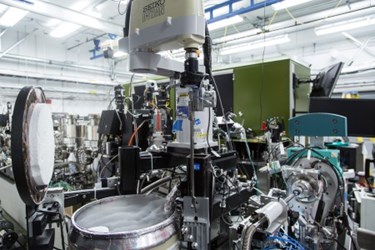Combining Robotics And X-Ray Lasers For Better Biological Imaging
By Chuck Seegert, Ph.D.

By combining one of the brightest X-ray lasers in the world with a robotic sample-handling device, scientists at the Department of Energy’s Stanford Linear Accelerator Center (SLAC) have developed an efficient and reliable way to obtain high-resolution images of biological samples typically too small and fragile to study with other tools.
SLAC is a world-renowned facility affiliated with the Department of Energy. It houses one of the brightest X-ray lasers in the world and has pushed biological imaging forward on many fronts. Many Nobel Prizes have come from work performed at SLAC since it opened more than 50 years ago.
Recently, yet another cutting edge advance has come from SLAC the enables the Linac Coherent Light Source (LCLS) to dramatically decrease the time and material required to crystallographically study rare specimens, according to a recent press release from SLAC. Traditionally, millions of crystalline samples are streamed in a liquid media through pulses from the LCLS. These randomly tumbling samples pass through the laser and, after significant analysis, a picture of biological samples is obtained.
Unfortunately, these crystalline samples can be damaged or destroyed when exposed to a powerful X-ray pulse, which led to a need for more efficient methods, according to a study published by the team in the Proceedings of the National Academy of Sciences.
To reduce the sample size required, the team developed a robotic specimen handler that presents crystals one at a time to another critical instrument called a goniometer, according to the press release.
The goniometer takes individual crystals delivered by the robotic arm and delivers them into the path of the laser, according to the press release. Combined with a custom software package that locates the position of the crystals in arrays of samples, the new approach allows increased flexibility in how the samples are held. It also enables greater varieties of samples to be studied.
"This is an efficient, highly reliable and automated way to obtain high-resolution 3-D structural information from small sizes and volumes of samples, and from samples that are too delicate to study using other X-ray sources and techniques," said Aina Cohen, co-leader of the Macromolecular Crystallography group in the Structural Molecular Biology (SMB) program at SLAC’s Stanford Synchrotron Radiation Lightsource (SSRL), according to the press release.
Cohen’s experience with robotic sample-handling systems spans more than a decade, and she oversaw the development of the new platform.
Pulsing lasers is an important part of understanding time-dependent phenomena. Recently, a new method of producing X-ray pulses was developed that can be deployed in a tabletop-sized device.
